MAKING MUDBRICKS
The major material that was used in the architecture at Alalakh was primarily mudbrick. The use of stone for building foundations was mostly limited to large scale structures such as the Levels IV and VII palatial and administrative complexes. With the exception of scrappy stone foundations used in the last phases of the site, the primary construction elements in the architecture were defined by sun dried mudbricks. Most noticeable were the varieties in the composition of mudbricks found from the earliest levels to the latest, as well as the variations within contemporary levels at the site itself. This variation prompted us to do more research on the use and production of mudbricks. Mudbrick samples were collected from all excavated architectural phases for analysis. The soil data from these provides an understanding of construction standards and variation throughout the occupational periods, as well as information about the geomorphology of the site.
In addition to the technical analyses, we launched a project to make mudbricks and subsequently construct mudbrick structures to better understand their production, properties, and use. Two workers (Hasan Ay and Isa Ökten) from the Atchana village, with the participation of the excavation crew, worked on this project from 5.30-13.30 for 7 weeks. The total amount of mudbricks produced reached 3100 after 35 days. These newly made bricks were then used during several more of our experimental projects (making a bread oven and burning down a model house). The rest were stored under plastic sheets for future projects.
The mud brick production area was located where we recycled the earth excavated from Squares 64.72 and 64.82 on the elevated southwestern rise at the site. Loads of straw were brought in from the village by tractor. Since the production of mudbricks was done on top of the archaeological site, mud mixing pits were not dug to preserve the strata; instead, the earth was piled into mounds and straw was mixed in. The water supply was brought in from the village with water tanks.
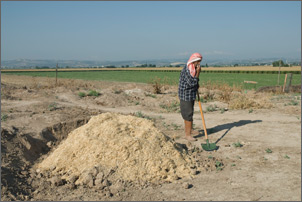
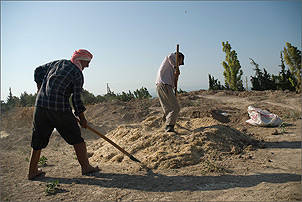
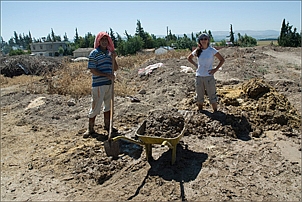
Two wooden mold frames representing different sizes of mudbricks were made by a carpenter in Antakya. The first mold was fabricated to make three 40 x 40 x 12 cm mudbricks at once. The second mold was designed to have three beds measuring 40 x 20 x 12 cm. The sizes are based on historical mudbricks discovered at Alalakh during excavations.
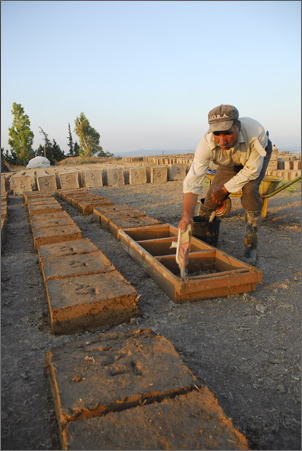
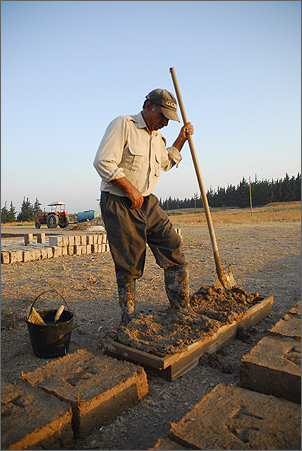

After the mud was poured into the mold, the bricks were stamped with the letters AT, the general code that is used in the registration system of the Alalakh excavations. This stamped brand will serve as an identification when used in building restorations in the future.
After the excavation of multiple levels of palaces by Leonard Woolley during the 1930-1940s, the palaces were left exposed to natural conditions for 70 years, which dramatically damaged the mudbrick structures. With the exception of the east wing of the Level IV Palace, where a metal awning provided shelter from 1980 onwards, the rest of the mudbrick architecture was not protected from deterioration. The overgrown vegetation damaged and cracked the mudbrick walls, including the basalt and limestone orthostats. Foxes and various ground-dwelling animals, such as prairie dogs, dug holes right through the walls. This damage required the urgent attention of a restoration and preservation project.
The restoration of the Alalakh mudbrick palaces will be a difficult task to accomplish. The mudbricks of the extant walls are heavily burnt, and rock-hard vitrification provided a natural preservation environment. Nevertheless, the collapsed and eroded sections of the walls should be cleaned and stabilized in order to prevent ongoing damage. This will necessitate the repair of some wall facades and tops using new mudbricks. Having a good color balance between the old and new mudbricks remains an important objective, and a long-lasting restoration result is crucial. Although a decision has not yet been made on a restoration project methodology, several ongoing experiments have set the stage for determining the most effective technique. Mudbricks will be baked to achieve the correct color and provide resistance to natural conditions. A second phase of surface treatment with conservation materials will stabilize the restoration.
Before the start of the restoration project, we will stabilize the Woolley excavation areas to limit the effects of weather and the environment. The mudbrick baking projects are part of this attempt to test the effect of direct/indirect exposure, as well as high/low temperatures. An immediate remedy is needed to stem the tide of deterioration by producing long-lasting mud bricks, which can then be used to restore the standing architectural remains before it is too late.


